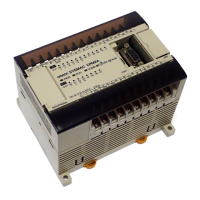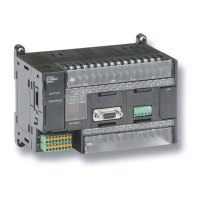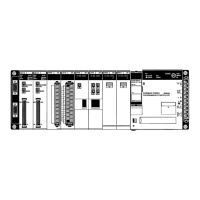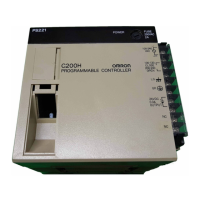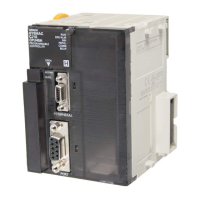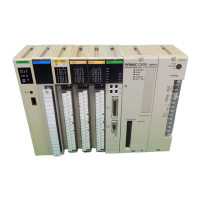24
7. PC Status Indicators
These indicators show the operating status of the PC, as shown in the fol-
lowing table.
Indicator Status Meaning
POWER (green)
ON Power is being supplied to the PC.
OFF Power isn’t being supplied to the PC.
RUN (green)
ON The PC is operating in RUN or MONITOR mode.
OFF The PC is in PROGRAM mode or a fatal error
has occurred.
ERROR/ALARM
ON A fatal error has occurred. (PC operation stops.)
(red)
Flashing A non-fatal error has occurred. (PC operation
continues.)
OFF Indicates normal operation.
COMM (orange)
ON Data is being transferred via the Peripheral Port.
OFF Data isn’t being transferred via the Peripheral
Port.
8. Input Indicators
These indicators are lit when the corresponding input terminal is ON.
When a fatal error occurs, the input indicators change as follows:
Fatal error Input indicators
CPU Unit error or I/O bus error Turn OFF.
Memory error, no END instruction
error, or system error
The indicators will change with the
status of the input signal, but input
status will not be updated in memory.
9. Output Indicators
These indicators are lit when the corresponding output terminal is ON.
10. Analog Volume Controls
Setting these controls sets the contents of IR 250 and IR 251 from 0 to 200.
11. Peripheral Port
Connects the PC to a Peripheral Device, RS-232C Adapter, or RS-422
Adapter.
12. Expansion I/O Unit Connector
Either one Expansion I/O Unit or one Analog I/O Unit can be connected to a
CPM1-10CDR-/20CDR-/30CDR- CPU Unit. Also, up to three
Expansion I/O Units and/or Analog I/O Units can be connected in any com-
bination to a CPM1-30CDR--V1 CPU Unit.
Unit Components
Section 2-2
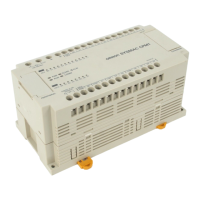
